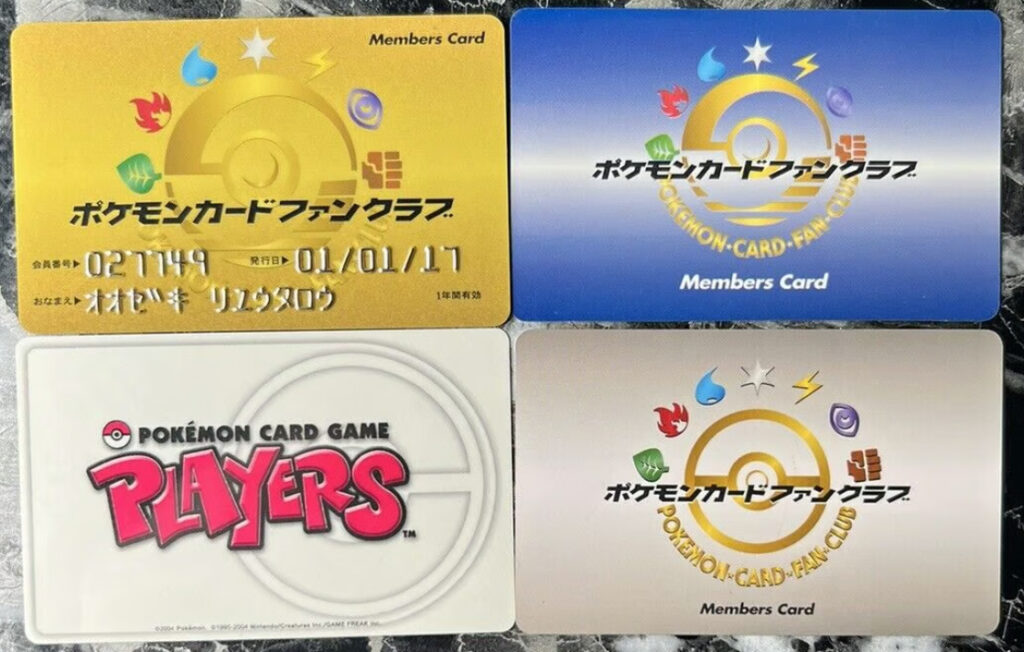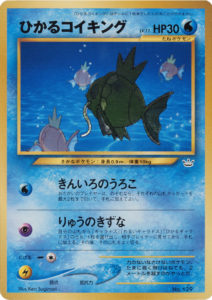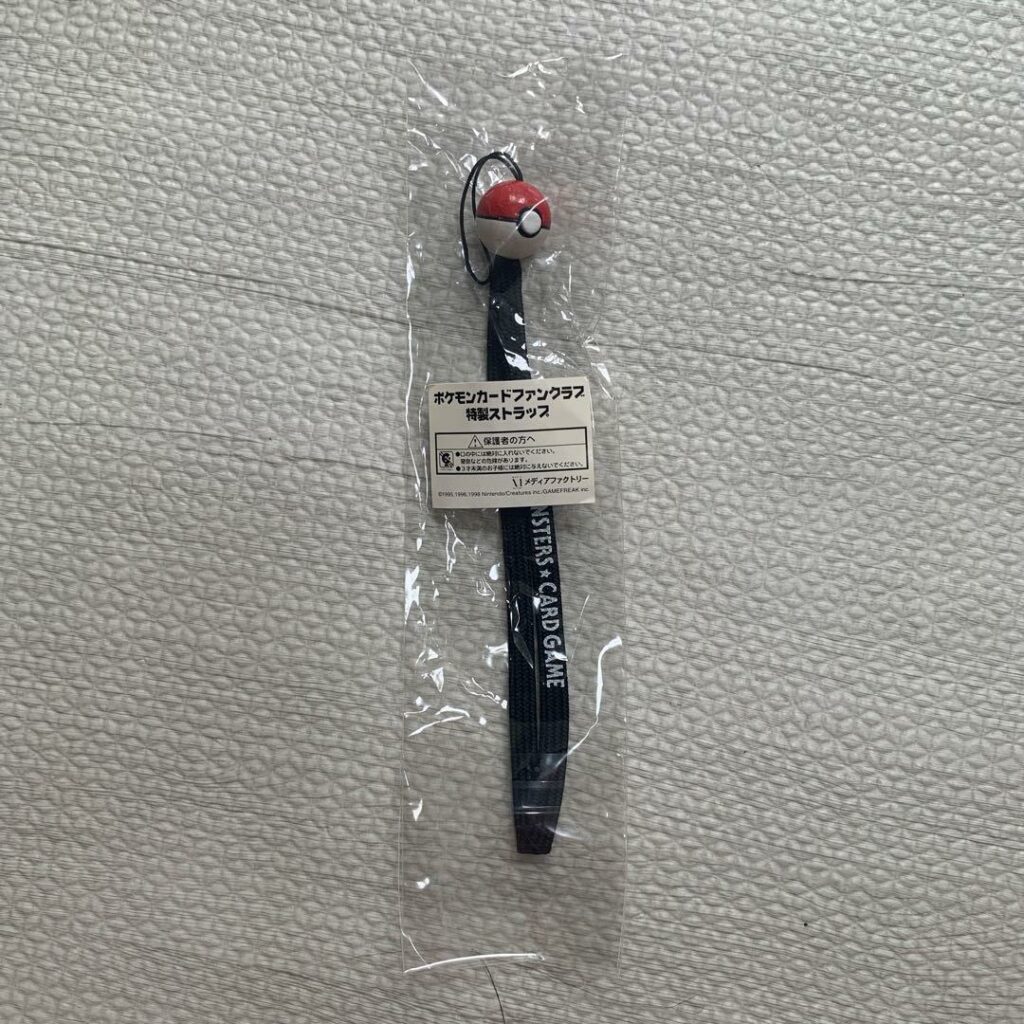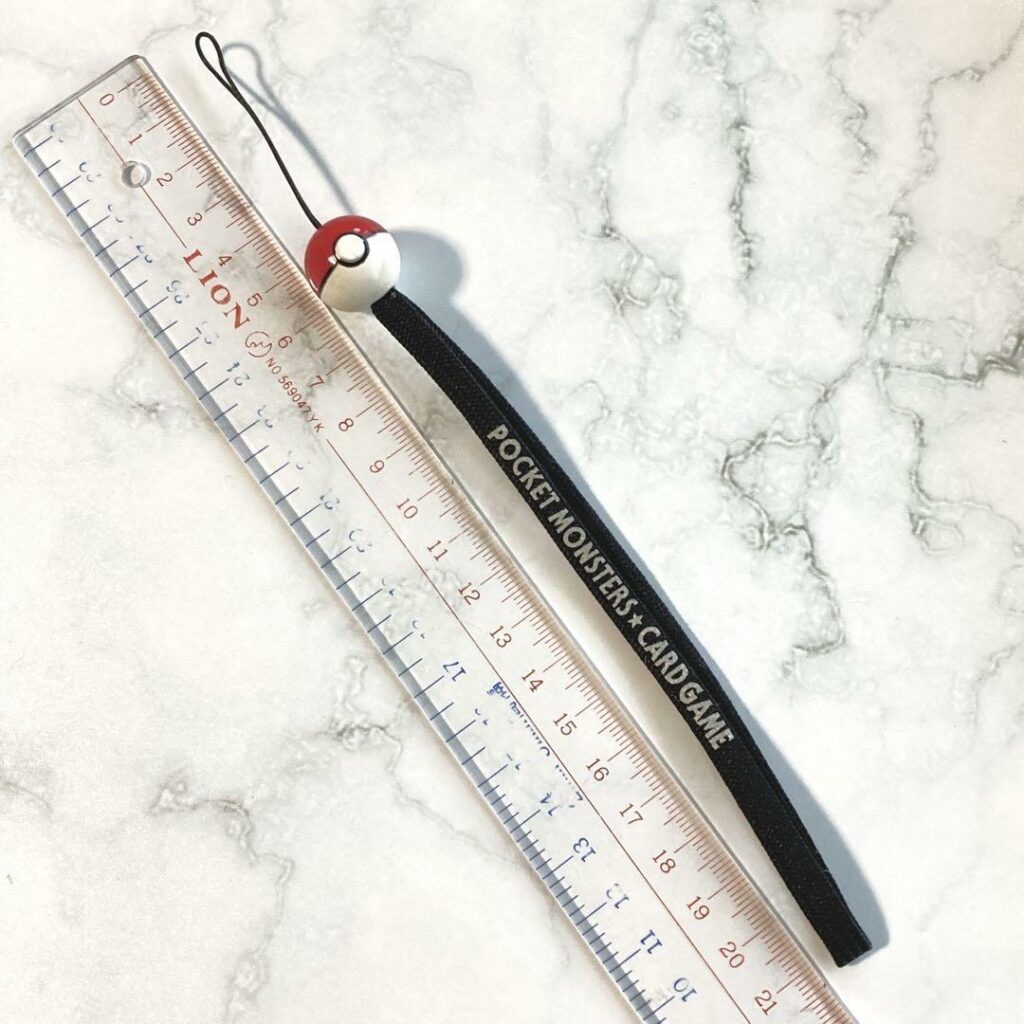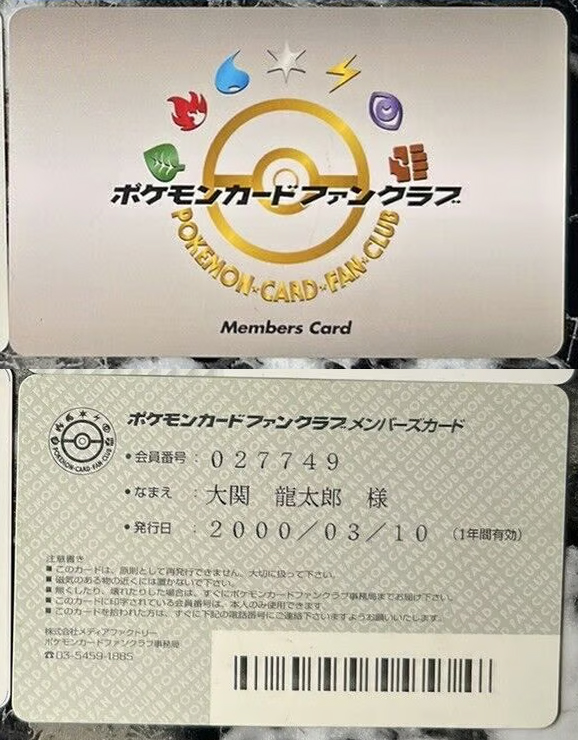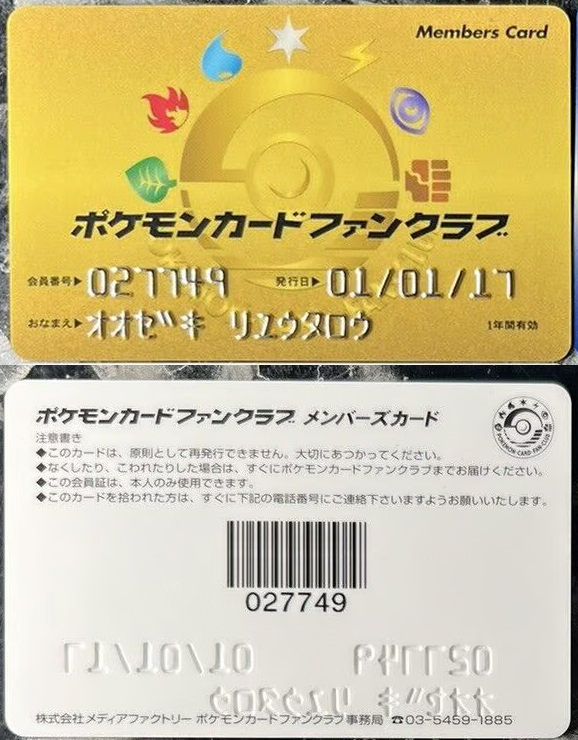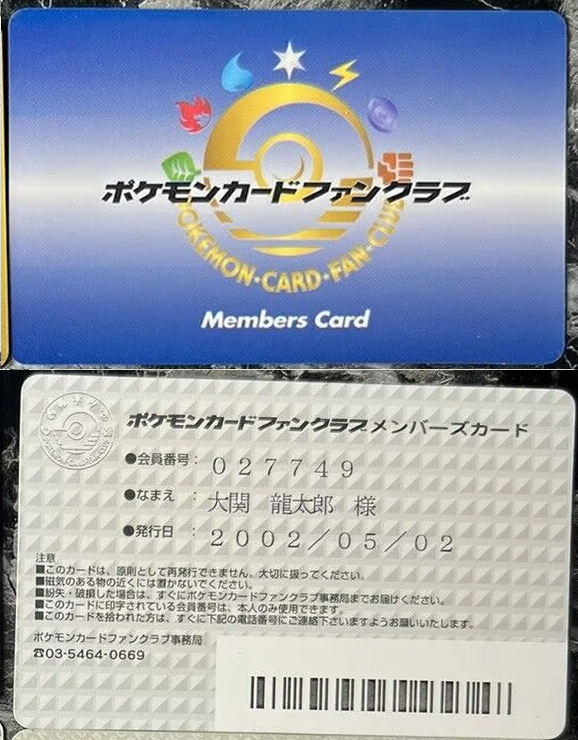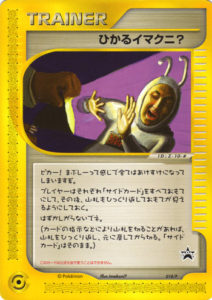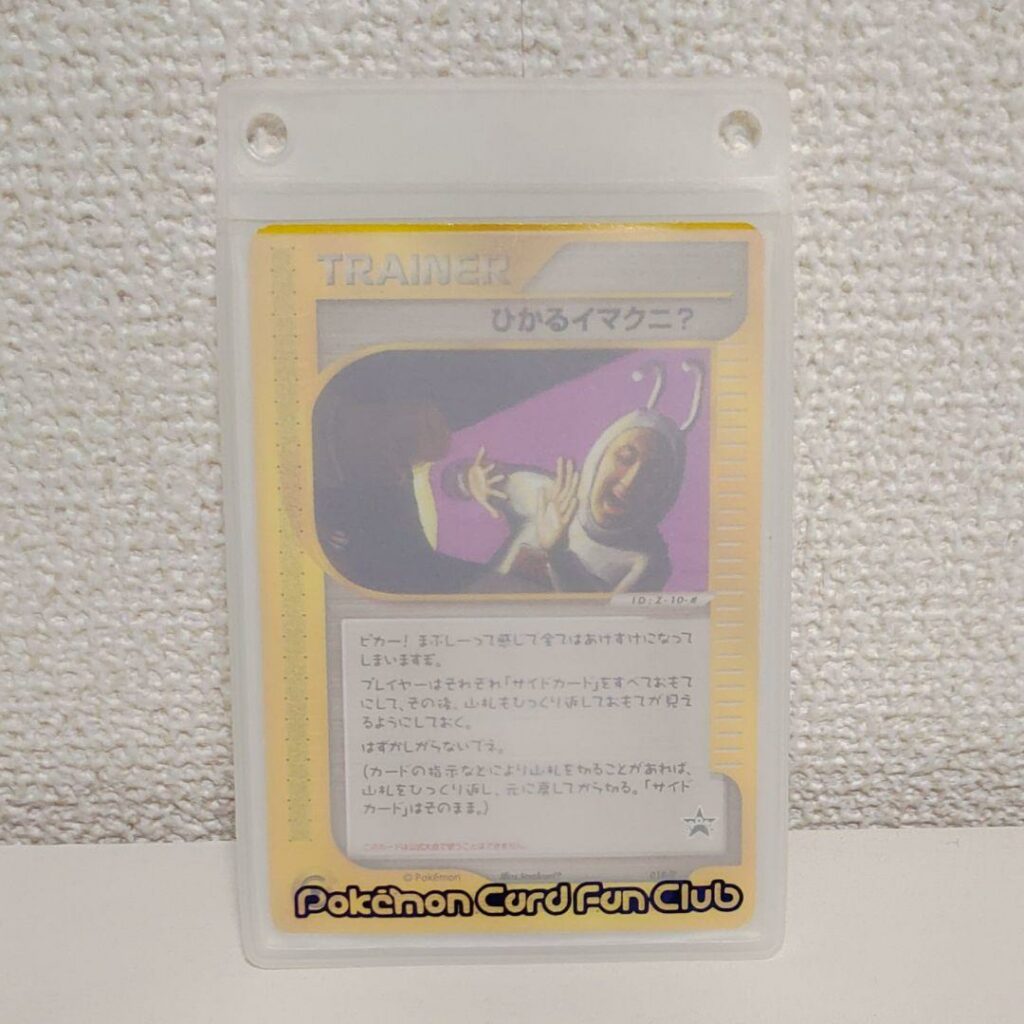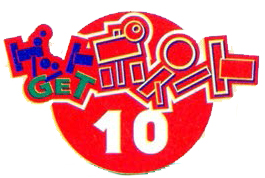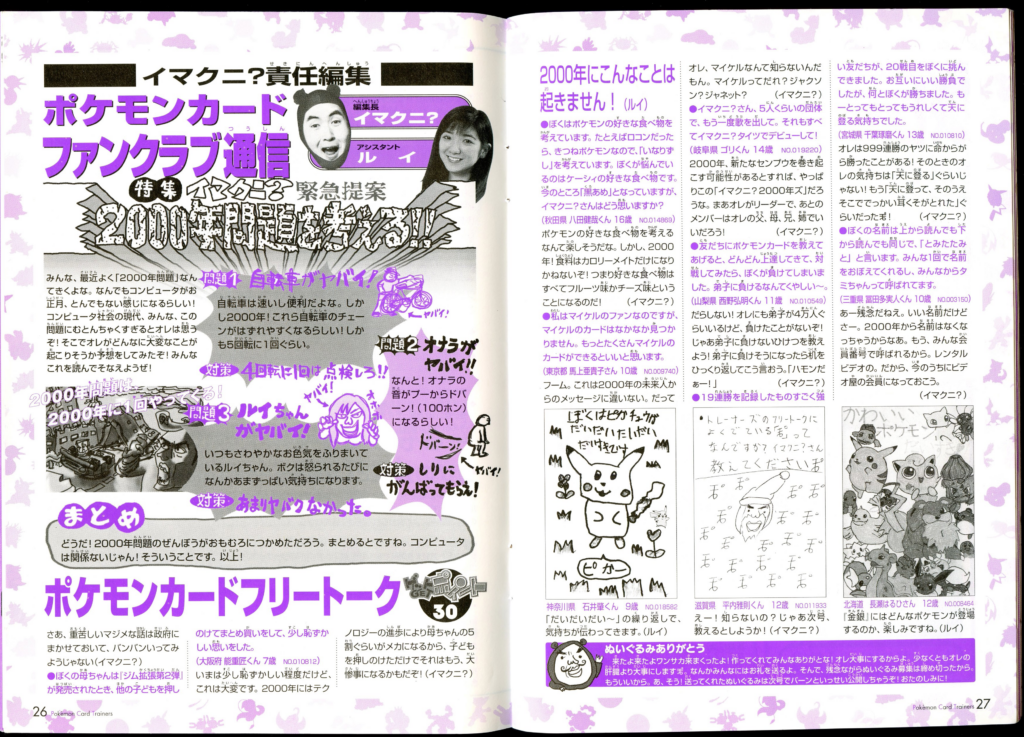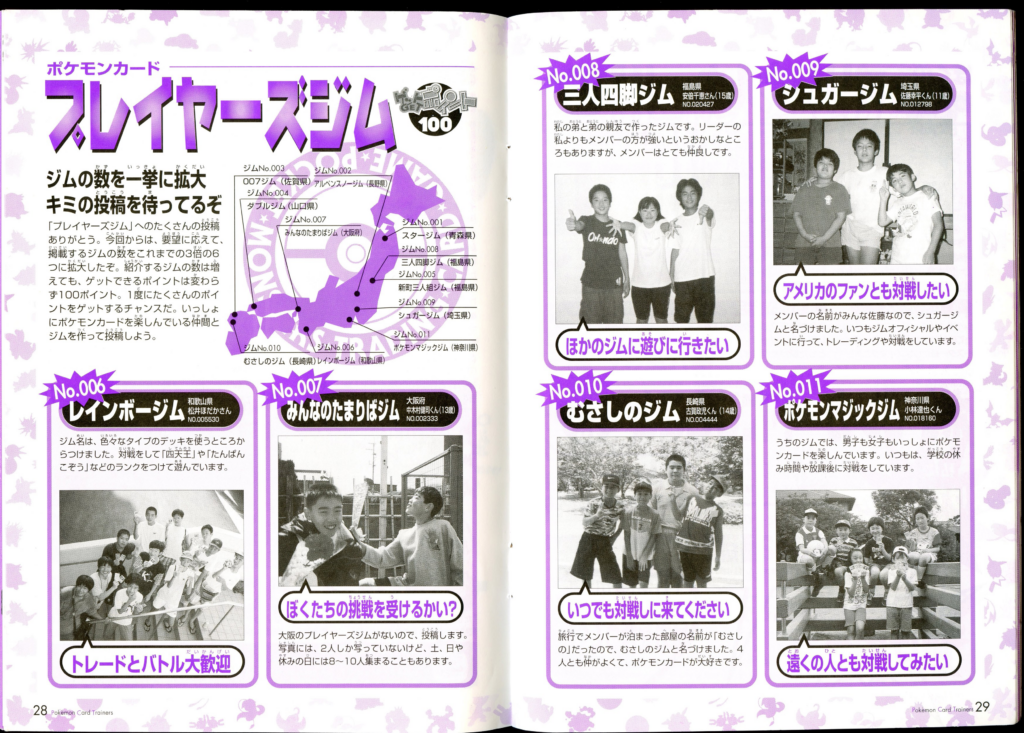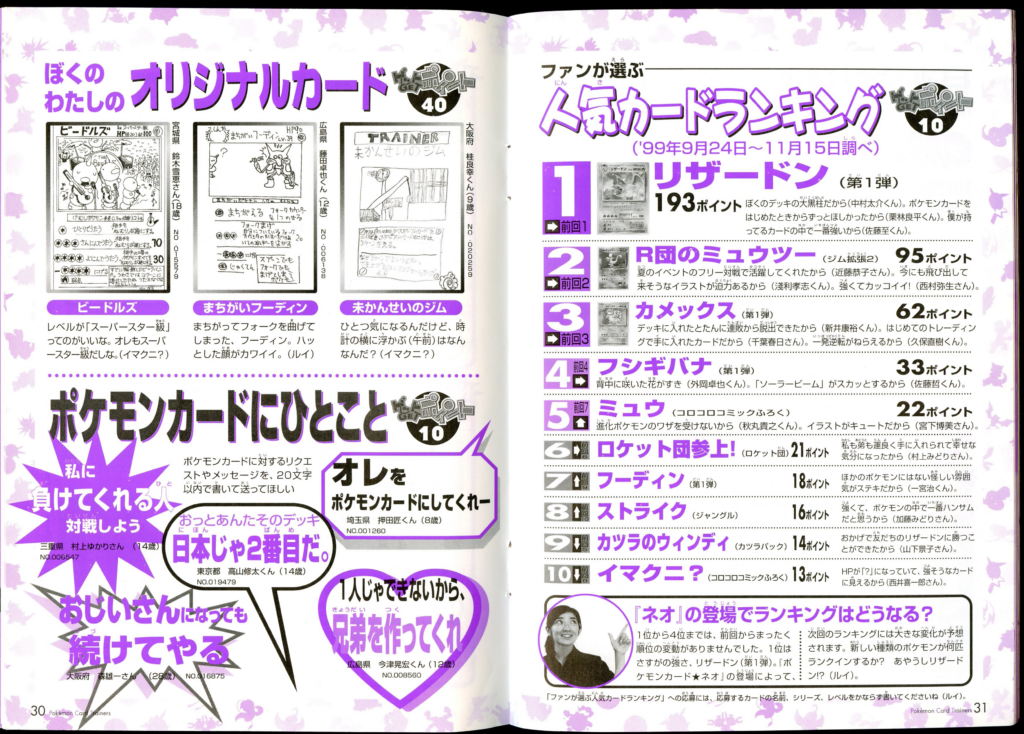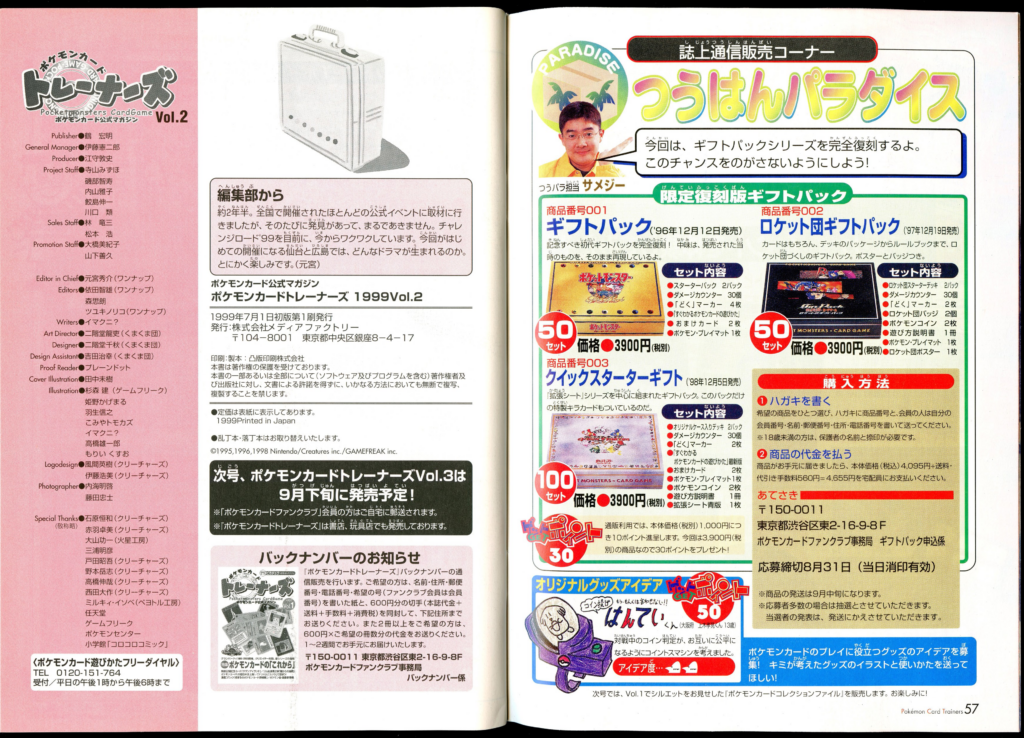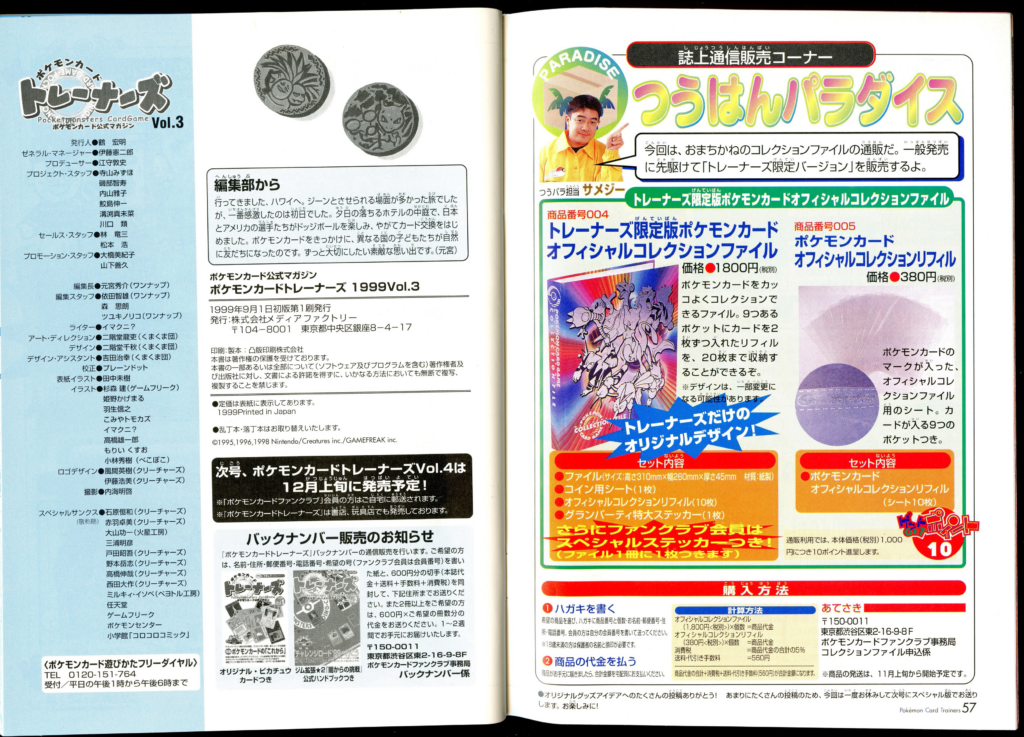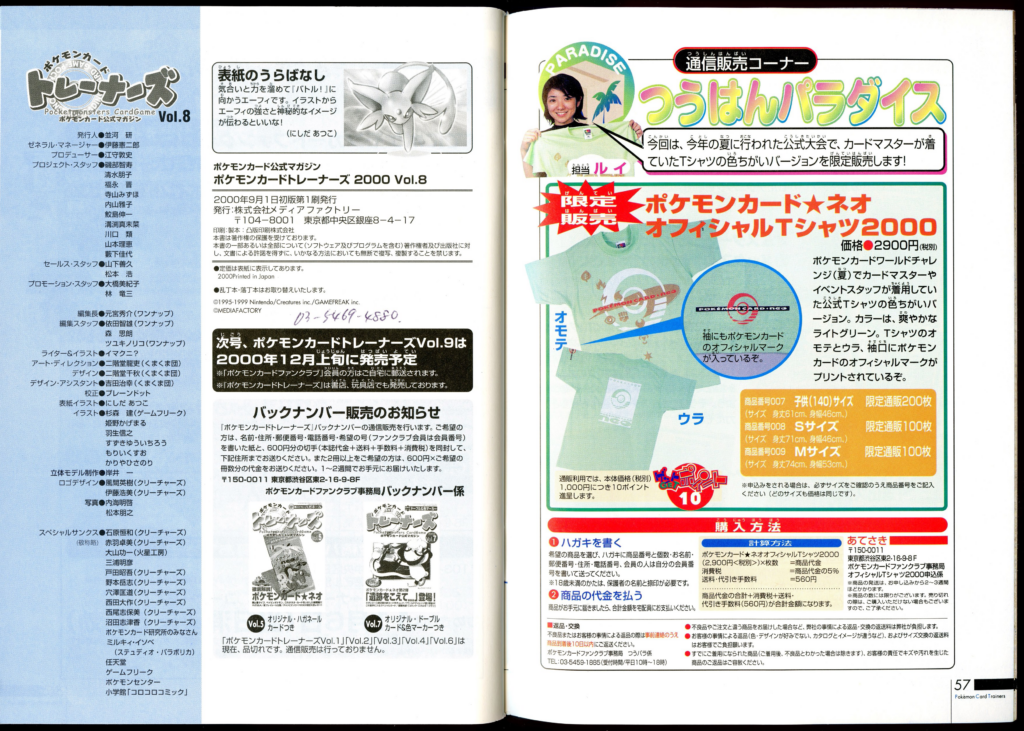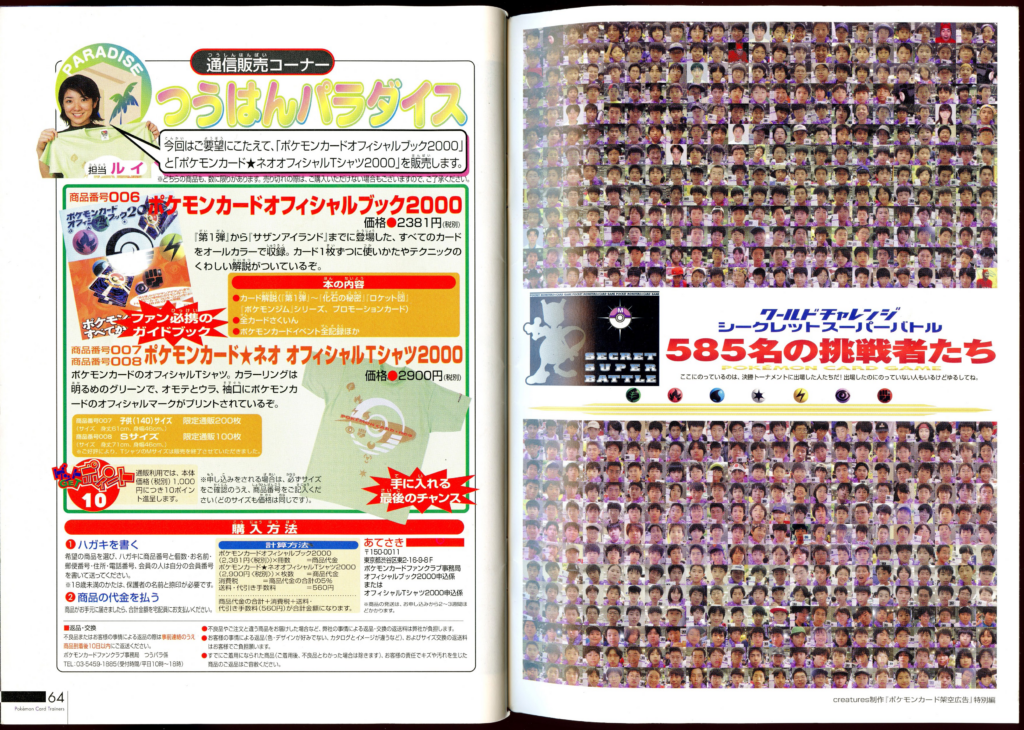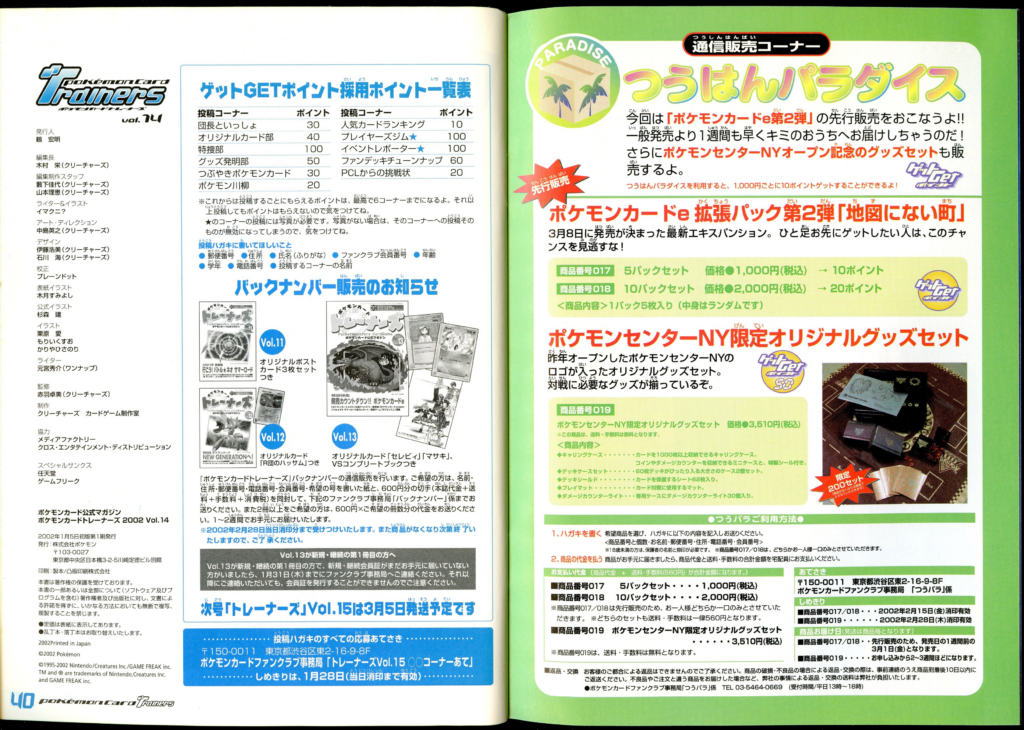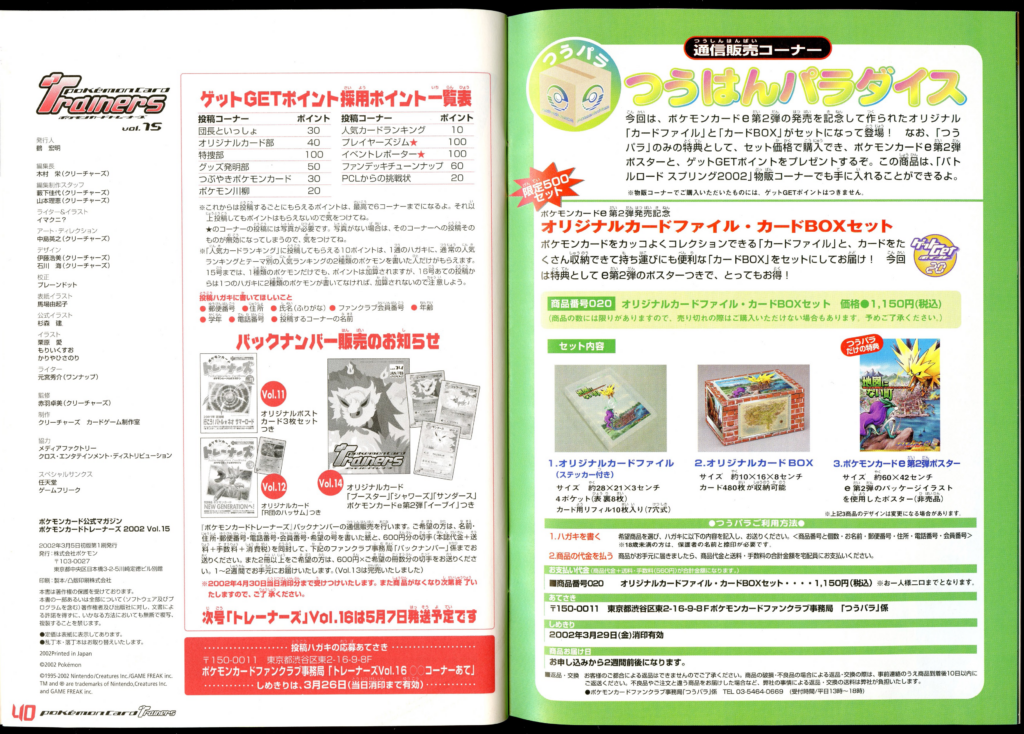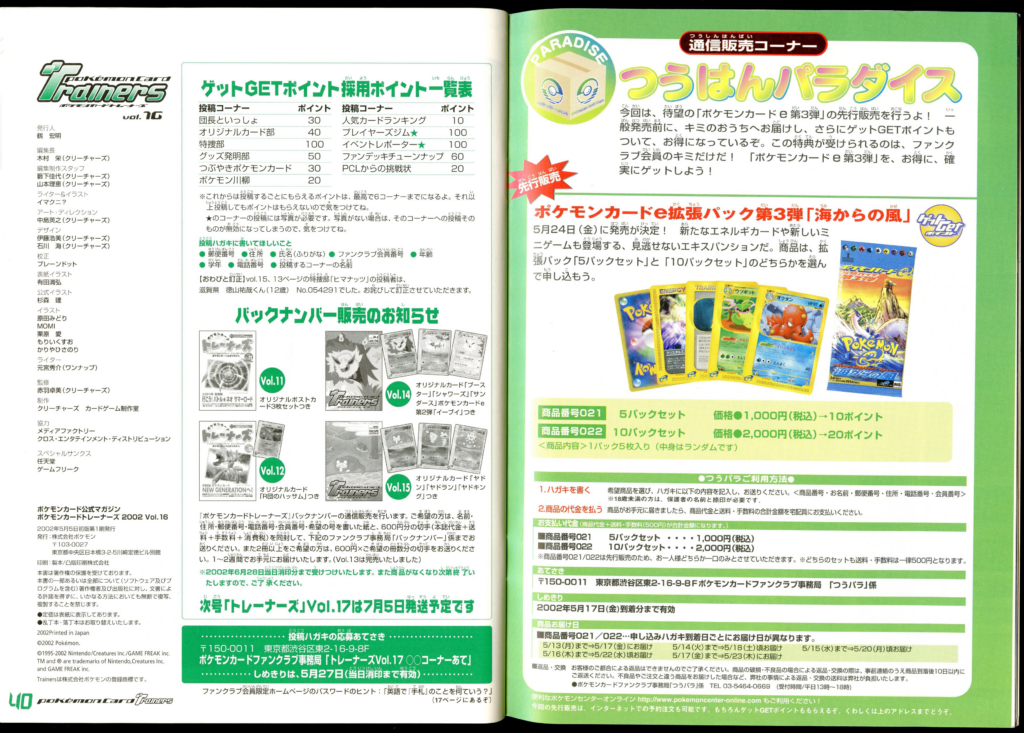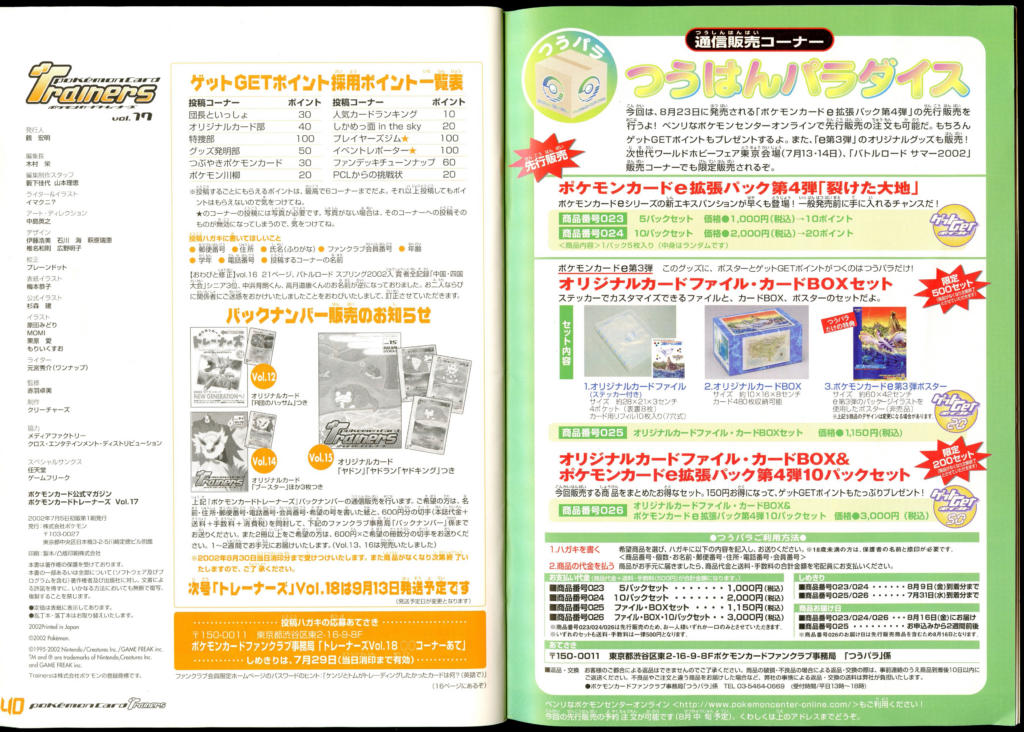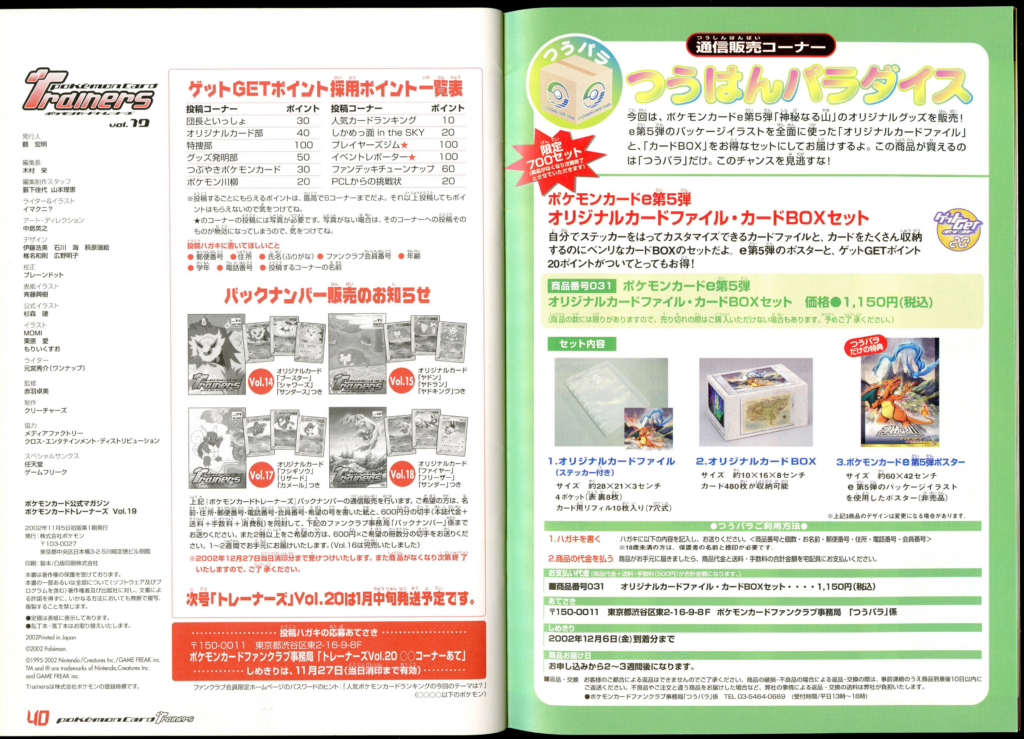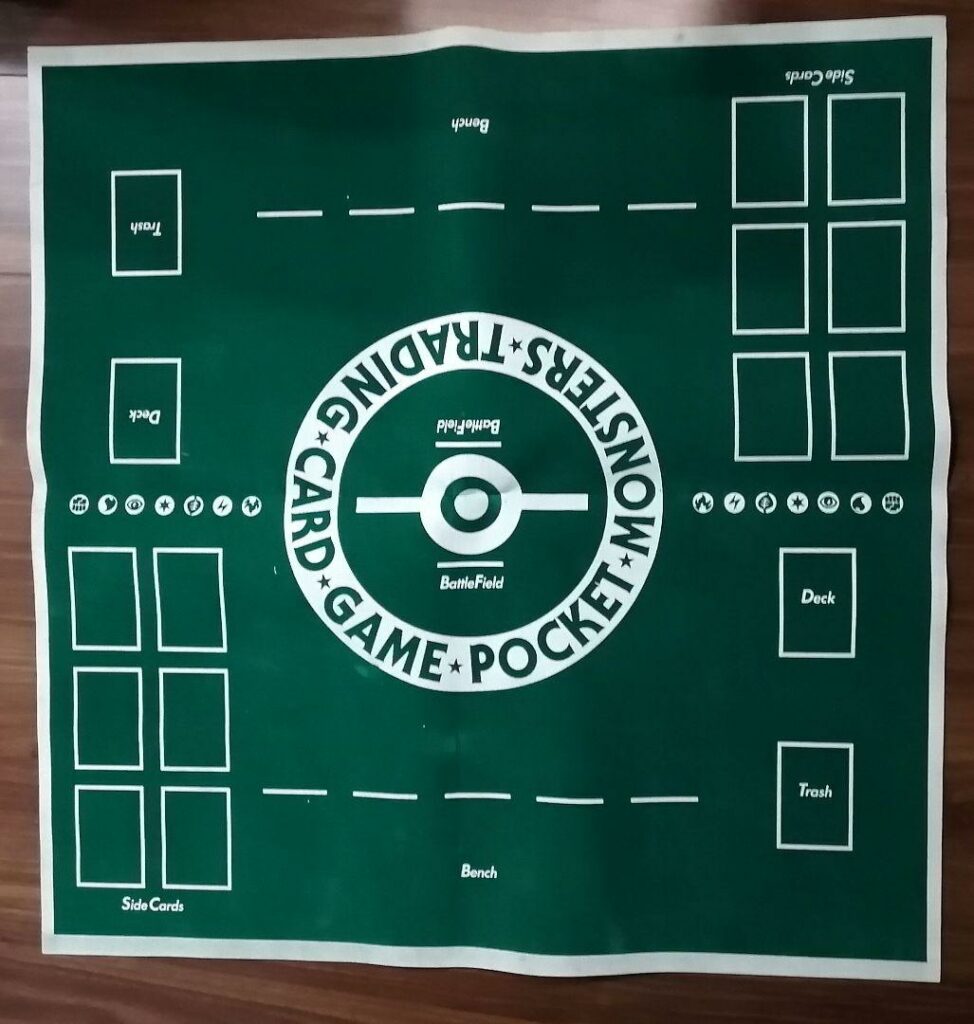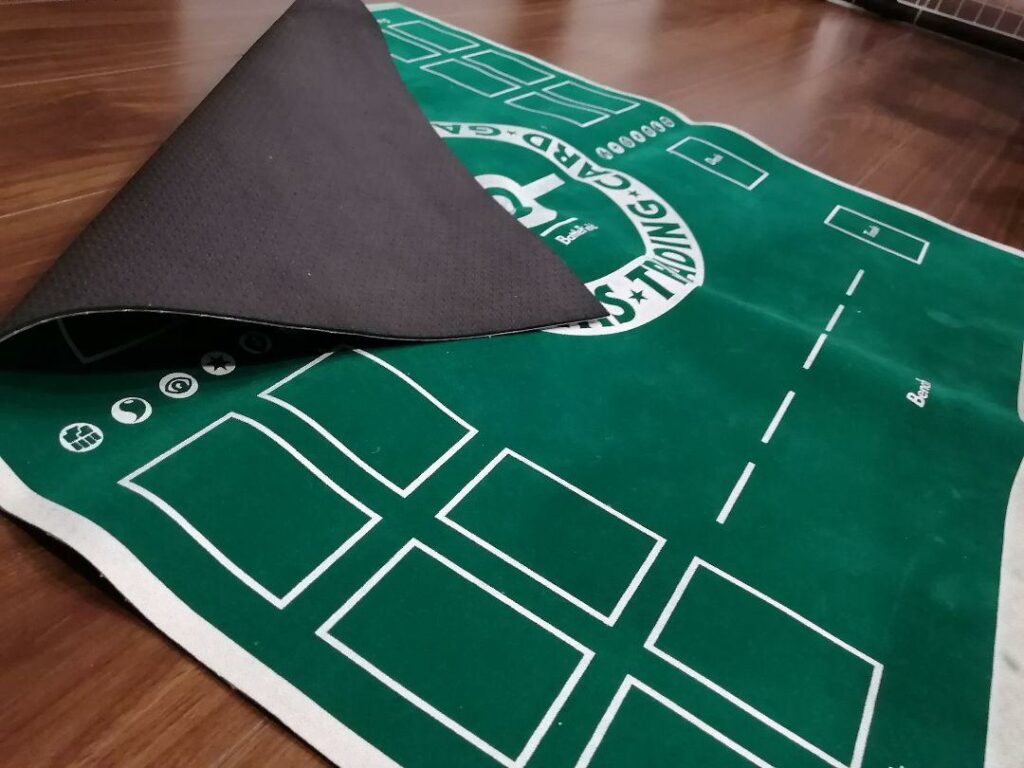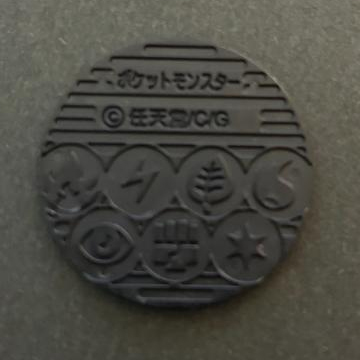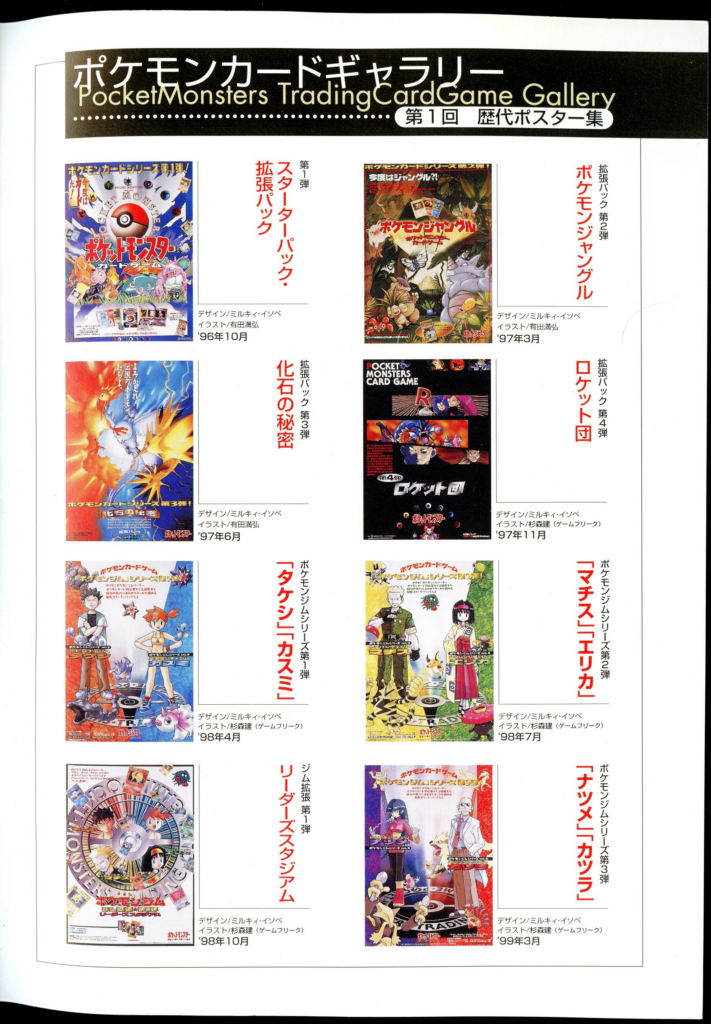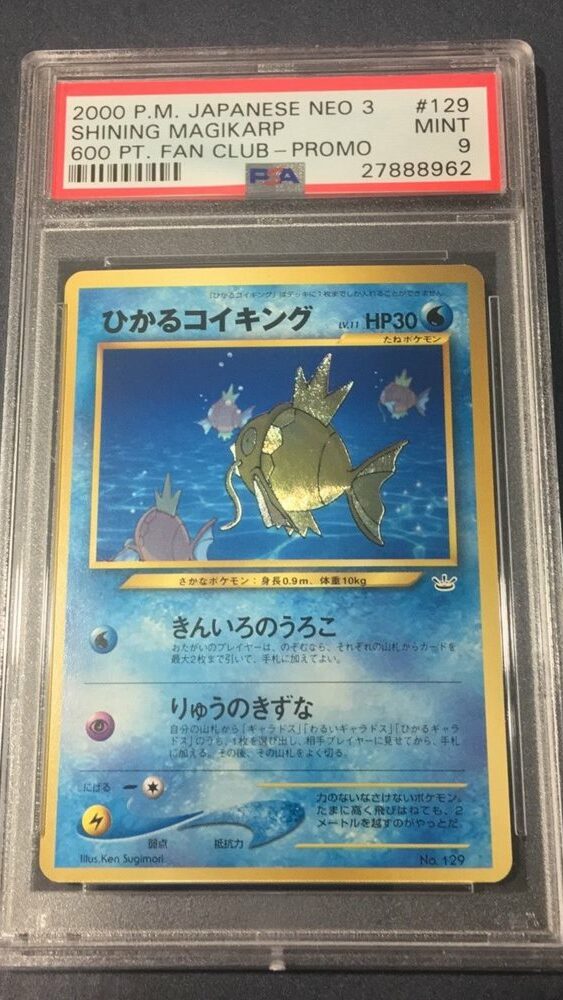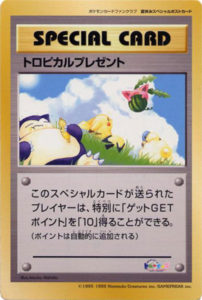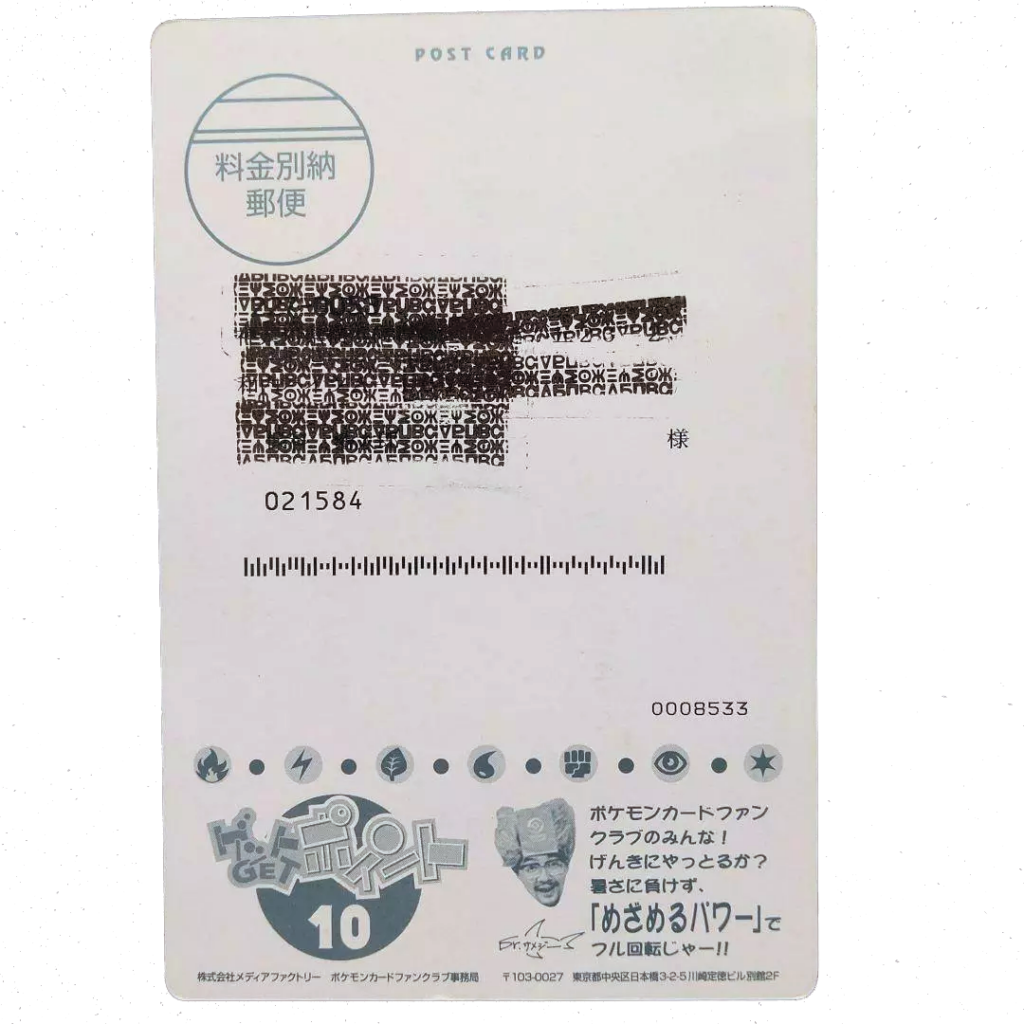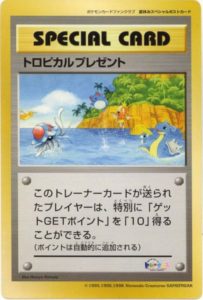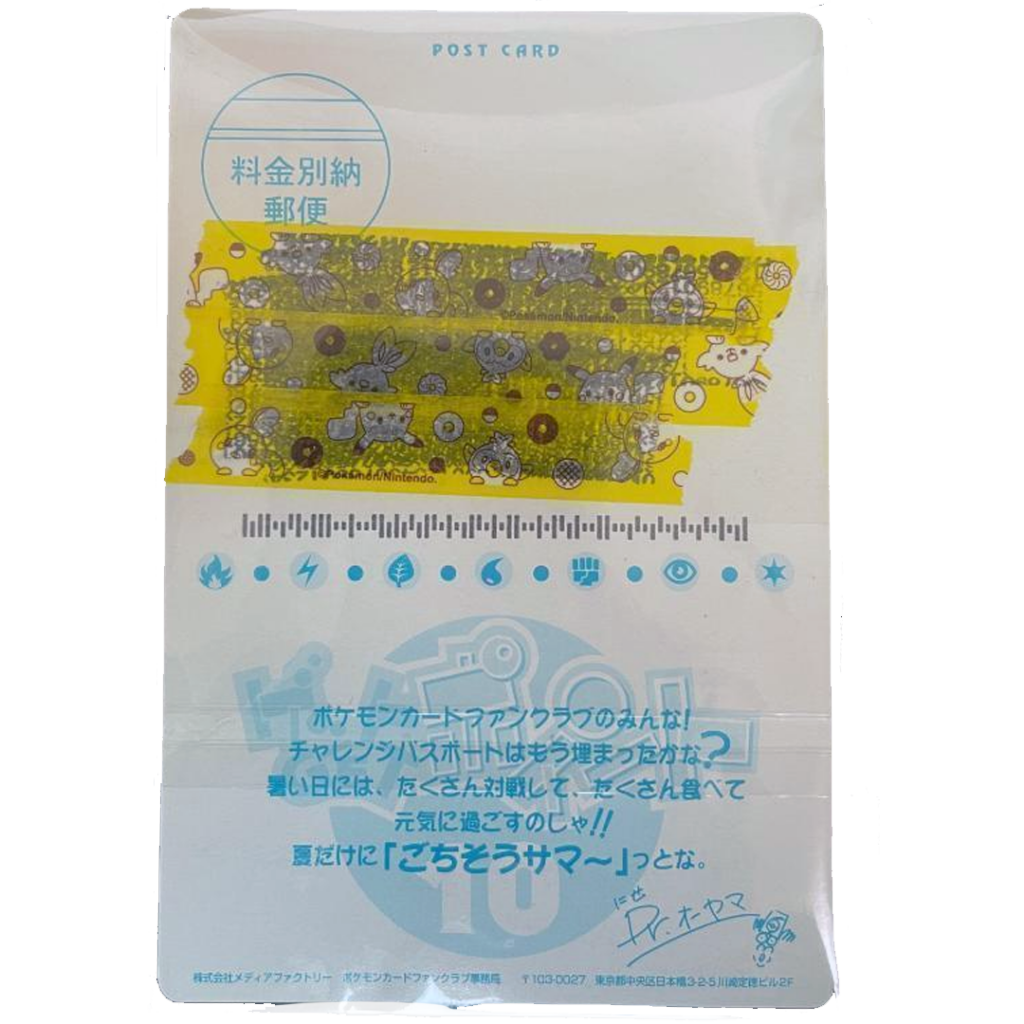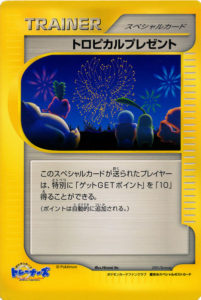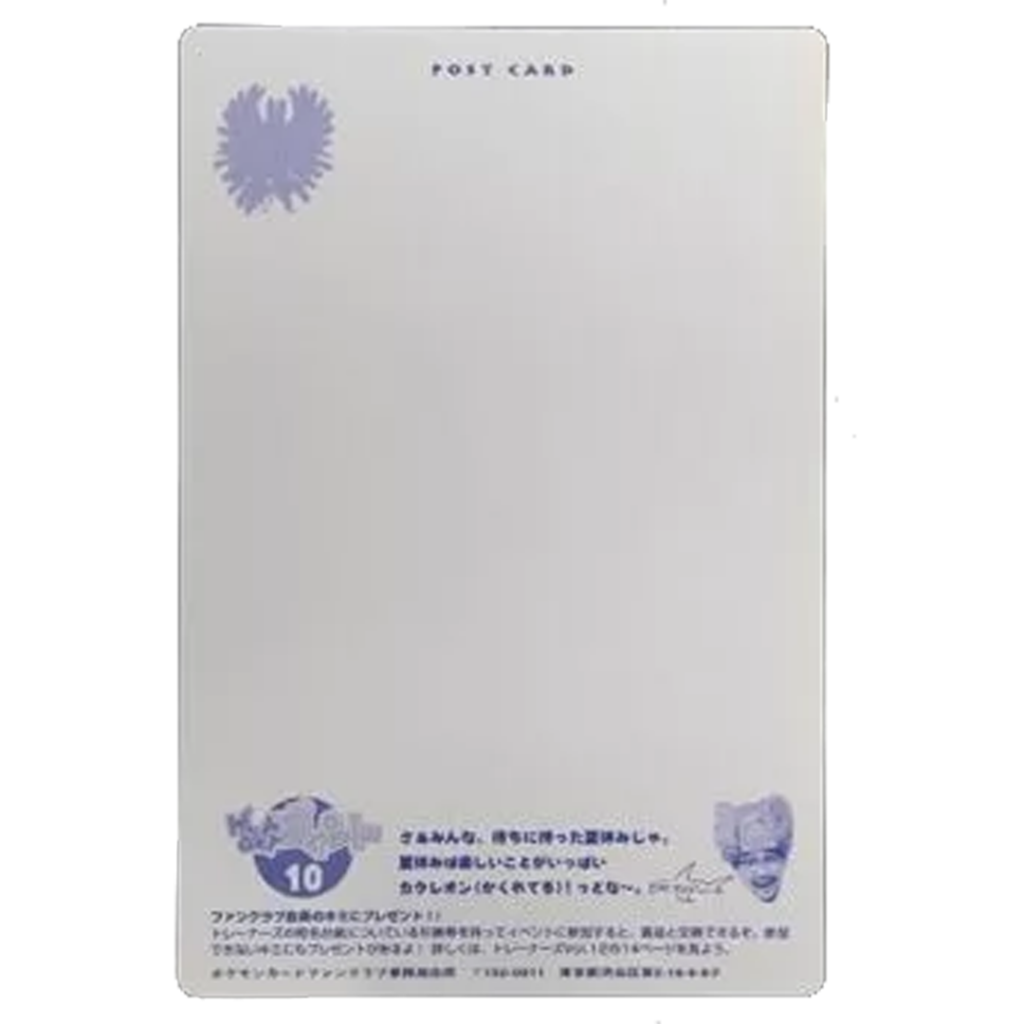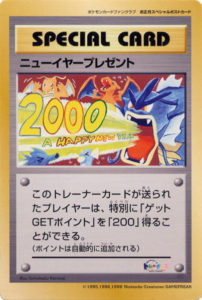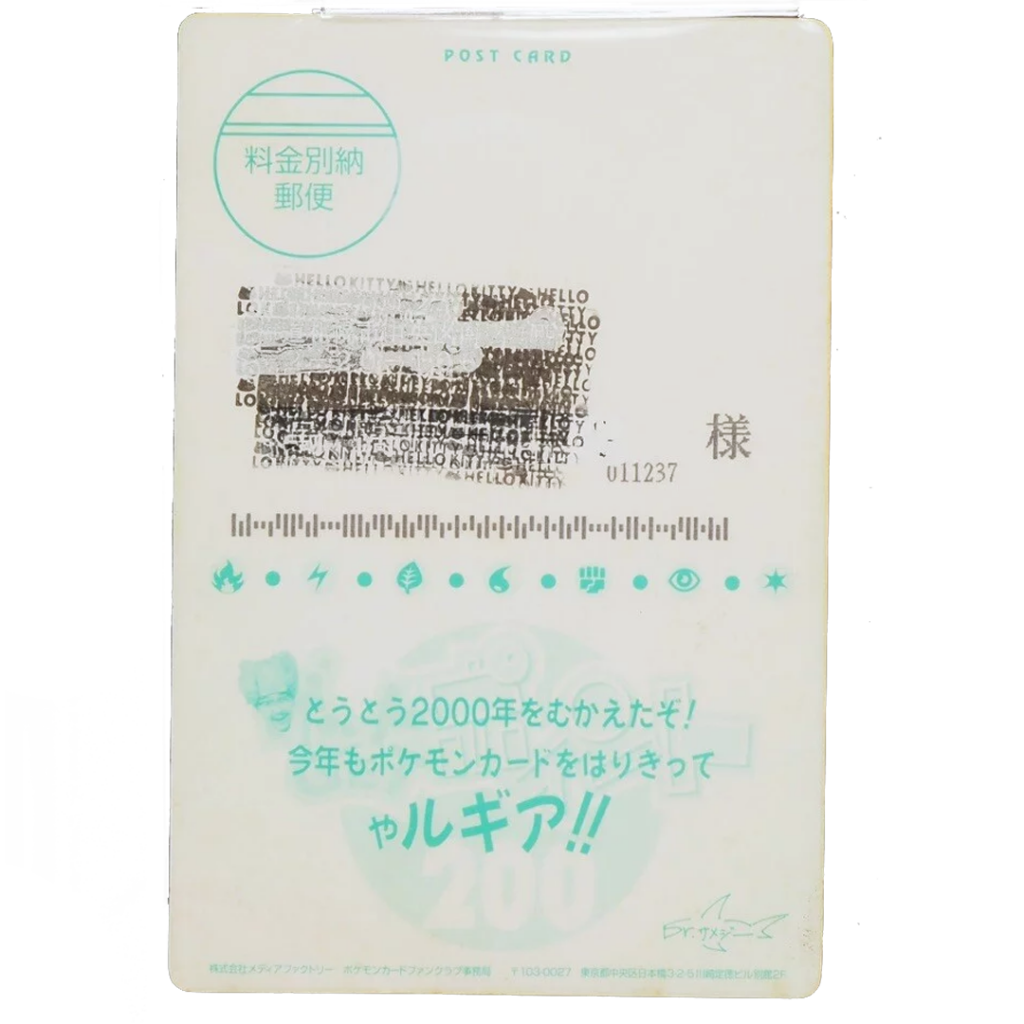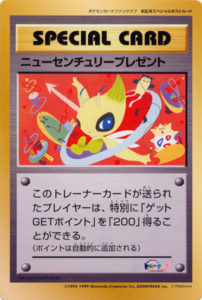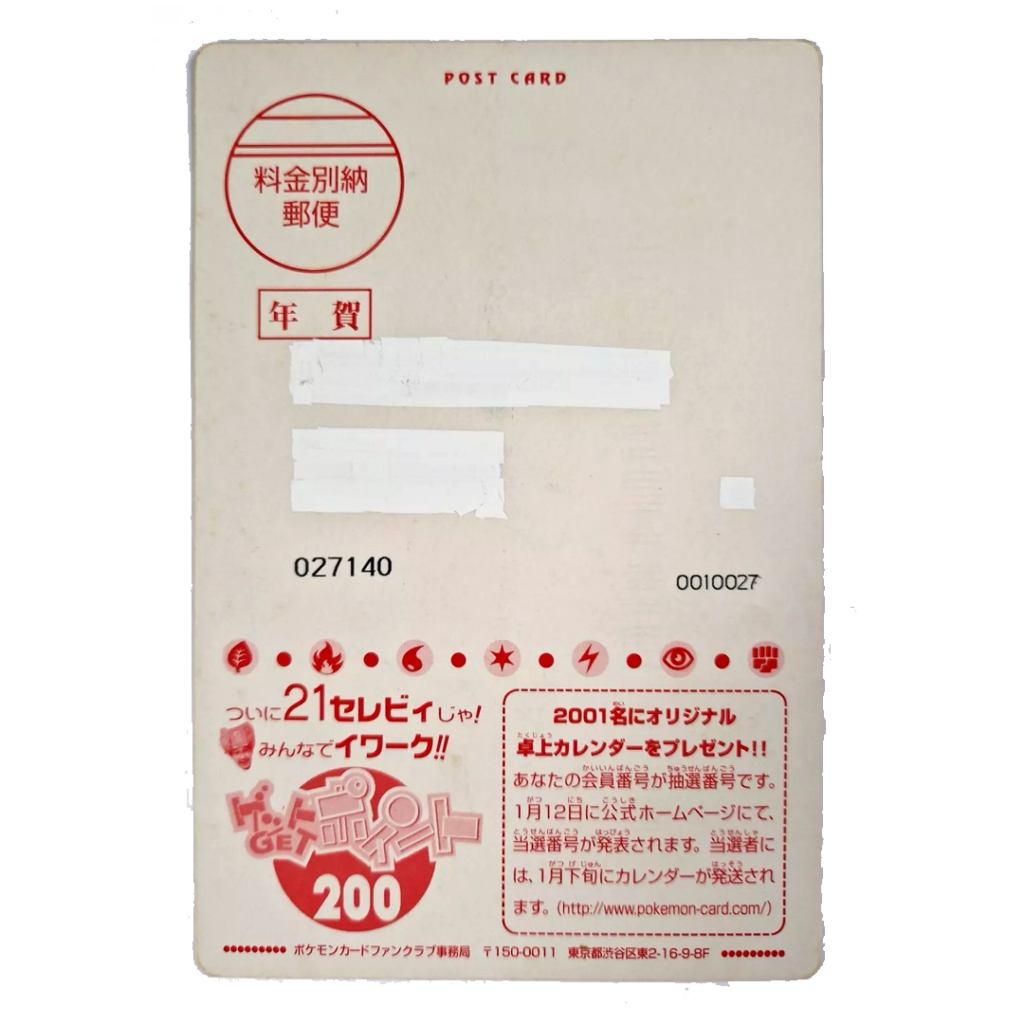The Pokemon Card Fan Club was established in 1999 as the first official membership club for Pokemon fans in Japan. It would run until 2002, after which it would be replaced by the Pokemon Players Club. The club was a means for Pokemon fans to engage directly with Media Factory and Pokemon’s staff, and would later serve as the foundation for Organized Play in Japan.
The Pokemon Card Fan Club was the source of several exclusive promos and merchandise, the most well-known being Porygon, Eevee, and Shining Magikarp.
Registration
The Pokemon Fan Club was launched in 1999 via the Pokemon Card Game Trainers (more commonly known as Trainers) magazine’s first issue, and on the official Pokemon TCG website. This magazine was the successor to the original Pokemon Fan Card Club Magazine.
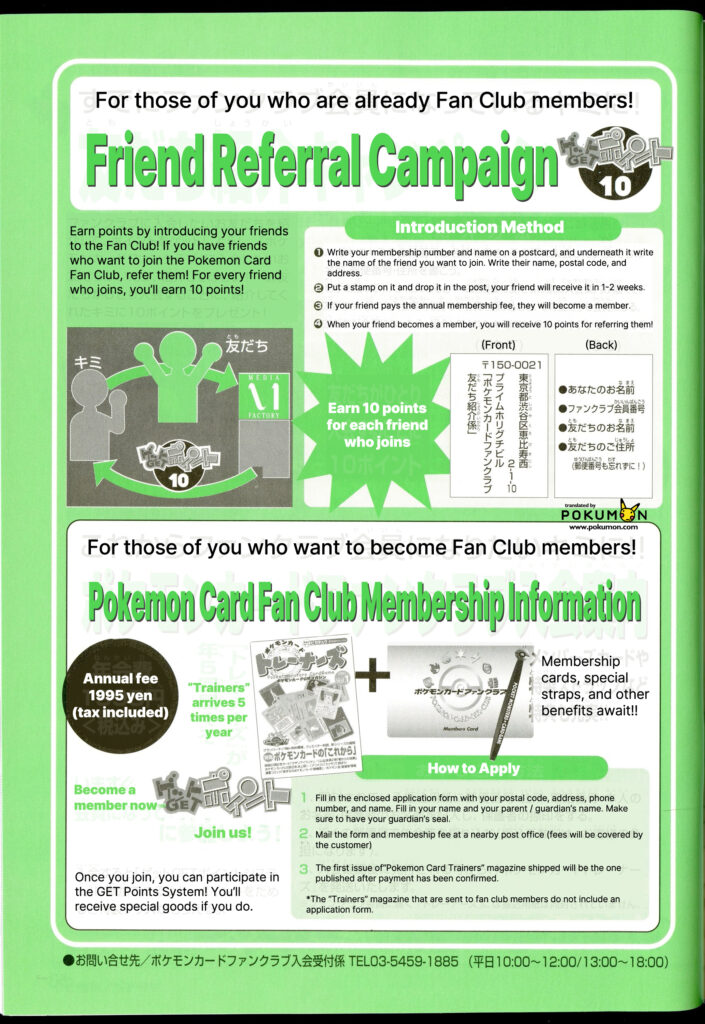
To join the club, readers would need to fill in an application form and include a transfer slip (essentially a Japanese bank check) for 1,995 yen. This would include a full year of membership, and included a subscription to the Trainers magazine. New issues would be published 5 times a year. They could also join the club via the official Pokemon TCG website.
Starting in January 2002, the price of registration would be raised to 2,500 yen, but 6 issues of Trainers would be published each year.
Subscribers would be mailed back a special Gameboy strap, along with a membership card valid for 1 year. During the 3 years that the Pokemon Card Fan Club was active, there were 3 different membership card designs.
In 2002, new members or returning subscribers would receive a Shining Imakuni? promo card for joining, along with a zippered card holder with “Pokemon Card Fan Club” written on it.
GET Point system
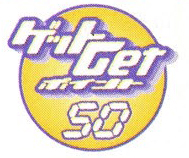
The “GET Points System” launched alongside the club. This was a way for members to earn points that could be redeemed for exclusive cards and merchandise. When the system was first announced in Trainers vol. 1, the exclusive prizes were not yet revealed, but would be revealed in later issues.
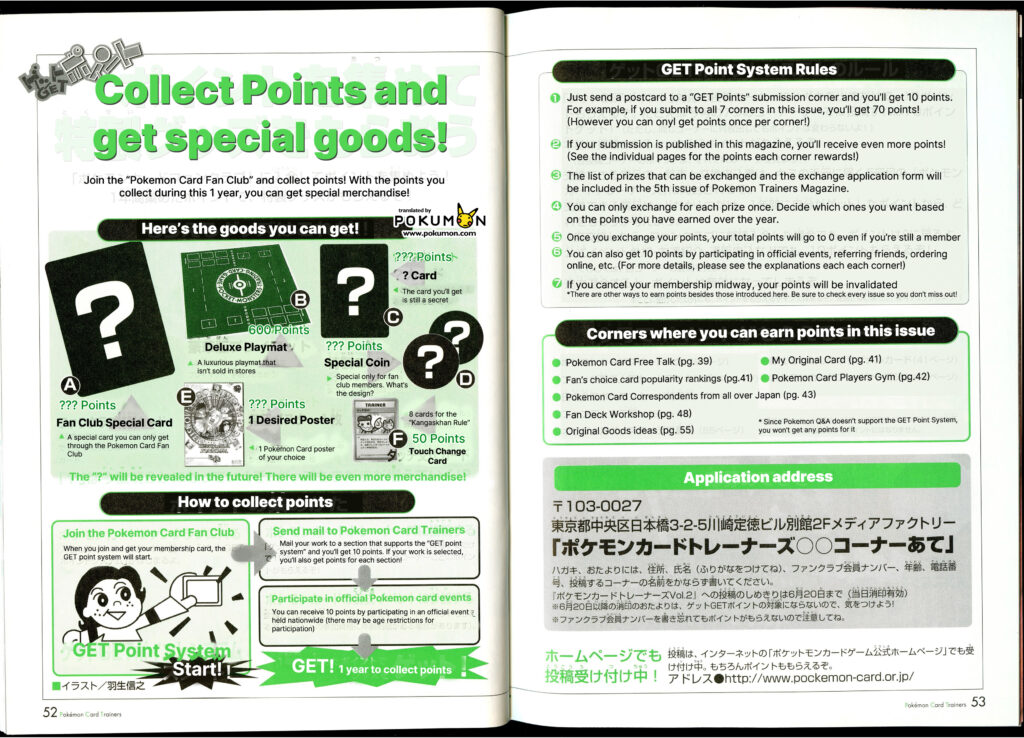
GET Points were mainly earned by entering official Pokemon TCG events or interacting with the Trainers magazine via mail. Different “corners” of the magazine would take in user-submitted questions, creations, or other content. Simply mailing in a submission would reward the reader, but if their submission was selected for print they would get even more points.
Magazine Submission Points
The point rewards would vary depending on the corner they were showcased in. Later issues of the magazine would also start rewarding more and more points. Below is a table of ways to earn points via the magazine’s submission system.
| Point-earning Method | GET Points rewarded |
|---|---|
| Signing up for the Pokemon Fan Club (annual) | 100 |
| Referring a friend to the Pokemon Fan Club | 10 |
| Sending in a submission (can be done once per corner every issue) | 10 |
| Pokemon Card Free Talk selection | 30 |
| Open a Players Gym and have it featured | 100 |
| Original Card selection | 40 |
| Voting in a survey poll | 10 |
| Special correspondence highlight | 100 |
| Fan deck workshop selection | 60 |
| Original Goods idea selection | 50 |
| Becoming a special correspondent for a tournament | 100 |
| Pokemon Card Laboratory Deck Tune Up | 60 |
| Pokemon Card Laboratory Challenge Question | 20 |
Attending official events
If members brought their membership card to official tournaments, they would receive 10 GET Points for any event they participated in. Additionally, major tournaments like World Challenge 2000, Neo Spring / Summer Road 2001, and Battle Road 2002 would award additional points.
Mail Order Paradise
Within each Trainers magazine starting from the Vol. 2 issue, there was a corner for “Mail Order Paradise”. In this section, Pokemon Fan Club members could purchase Pokemon merchandise by mailing in a post card. They would them receive a transfer slip they could mail back with the items they wanted to buy. They would receive their goods by mail a few weeks later. Every 1,000 yen spent would reward the purchaser with 10 GET points.
The catalog of items available were sometimes limited in quantity and changed with every issue. If more purchasers wanted a certain item than was available, there would be a lottery held to determine who actually got the purchase the items.
Vol. 6, 10, 11, 12, 13, 20, and 21 which didn’t have this mail order section. Vol. 6 was the 5th issue and thereby the first one eligible for point redemption, while Vol. 10 – 13 were when the magazine was going through a re-design, with a relaunch happening in Vol. 14. The final 2 volumes (20 and 21) also lacked the mail order section.
Vol. 2
- Gift Pack – 3,900 yen (limit 50)
- Quick Starter Gift Set – 3,900 yen (limit 100)
- Team Rocket Gift Pack – 3,900 yen (limit 50)
Vol. 3, 4, 5
- Official binder with 10 9-card sheets, a coin sheet, and special stickers – 1,800 yen
- Official 9-card binder sheets (set of 10) – 380 yen
Vol. 7
- Pokemon Card Official Book 2000, also known as the “Silver Bible” due to it being a complete list of all currently printed Pokemon cards – 2,381 yen
Vol. 8
- Pokemon Card Neo Official T-Shirt 2000 – 2,900 yen (limited by size)
- This was a different-colored version of the official T-shirt worn by staff members at official tournaments.
- 200 child size, 100 adult small, and 100 adult medium were available.
Vol. 9
- Pokemon Card Official Book 2000 – 2,381 yen
- Pokemon Card Neo Official T-Shirt 2000 – 2,900 yen (limited by size)
- 200 child size, 100 adult small were available
Vol. 14
- 5 packs of the Town on No Map expansion – 1,000 yen
- 10 packs of the Town on No Map expansion – 2,000 yen
- Pokemon Center New York Merchandise bundle – 3,510 yen (bonus 50 GET Points). Included a carrying case, deck box set, sleeves, playmat, and damage counter set.
Vol. 15
- Pokemon eCard Expansion 2 Bundle – 1,150 yen (Bonus 20 GET Points, limited to 500)
- Includes a card binder, storage box, and an exclusive poster. The binder and storage box could also be purchased at Battle Road 2002 events.
Vol. 16
- 5 packs of the Wind from the Sea expansion – 1,000 yen
- 10 packs of the Wind from the Sea expansion – 2,000 yen
- These packs would arrive before the set’s official release exclusively for Fan Club members.
Vol. 17
- Pokemon eCard Expansion 4 Bundle – 1,150 yen (Bonus 20 GET Points, limited to 500)
- Includes a card binder, storage box, and an exclusive poster. The binder and storage box could also be purchased at Battle Road 2002 events.
- A bundle was available that also included all the accessories along with 10 packs of the set for 3,000 yen (Bonus 50 GET Points, limited to 200).
Vol. 18
- Pokemon eCard Expansion 5 Bundle – 1,150 yen (Bonus 20 GET Points, limited to 200)
- Includes a card binder, storage box, and an exclusive poster.
- A bundle was available that also included all the accessories along with 10 packs of the set for 3,000 yen (Bonus 50 GET Points, limited to 500).
Vol. 19
- Pokemon eCard Expansion 5 Bundle – 1,150 yen (Bonus 20 GET Points, limited to 700)
- Includes a card binder, storage box, and an exclusive poster.
GET Point Rewards
Once per calendar year, Pokemon Fan Club members would receive a postcard along with their 5th copy of Trainers magazine that also showed their total number of GET Points accumulated. They would be able to mark down desired items from the GET Point catalog and mail it back to receive the items.
After mailing in this postcard, the member’s GET Point total would be reduced to 0. Therefore members had to try to utilize their points completely each time they redeemed them.
Vol. 4 Rewards
In Trainers Vol. 4, the full list of initial rewards was revealed for the first time. Vol.5 would be the first time members could redeem rewards, and the reward list would update with images of the available prizes.
Prize A – Porygon (700 points)
An exclusive Porygon promo card was the top GET Points prize at 700 points. When first revealed in Vol. 4, the card mockup of this Porygon used the pre-2000 card format layout.
This was corrected in subsequent issues, and the actual printed card would use the “neo” post-2000 card format layout.
This Porygon featured the GET Points system logo as its expansion symbol, and the text at the bottom of the card reads “Pokémon Card Fan Club special card”
This Porygon would also be shipped with a thick cardboard card, with punch-out markers of energy symbols.
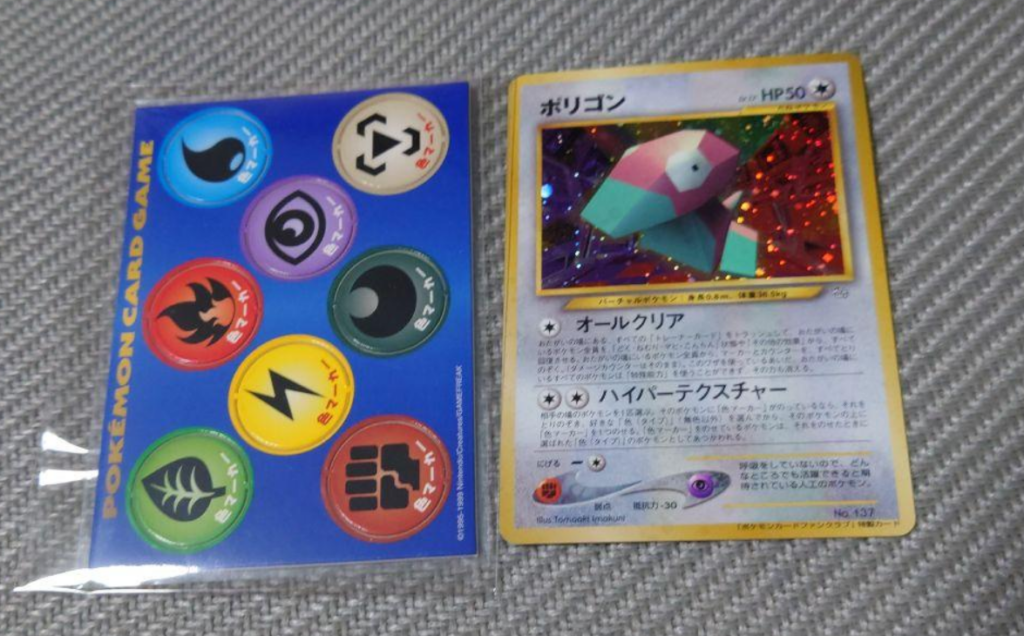
Prize B – Deluxe Playmat (600 points)
This playmat was one of the earliest official Pokemon playmats, and unlike the cloth one sold in 1997, it was also rubberized on the bottom, giving it an extra premium feel.
Prize C – Eevee (500 points)
An exclusive Eevee promo card was the 500 point prize. Similar to the Porygon, when first revealed in Vol. 4, this card’s format layout used the pre-2000 one.
In subsequent issues and when the card was finally printed, the card would use the “neo” card format.
Even though this Eevee required less points than the Porygon, due to the popularity of Eevee it remains generally more expensive on the secondary market than Porygon.
Prize D – Imakuni?’s Doduo Coin (400 points)
This coin was exclusive to the GET Point system and was based off the Imakuni?’s Doduo card printed in the Challenge from Darkness expansion.
Prize E – Poster of your choice (300 points)
This prize allowed members to pick a poster of their choice from a rotating catalogue of posters.
As new posters were released (generally with new expansion releases), members would be able to pick them for redemption.
Prize F – 8 copies of Touch Change! (50 points)
Originally distributed at the Kangaskhan Parent / Child Tournaments held as side events at the Lizardon Mega Battle and Kamex Mega Battles, this trainer card was used to enable 2v2 gameplay. Playing the card would allow one player on the team to swap out for the other.
Spending 50 points would get a member 8 copies of the card, enough for 2 full playsets (4 copies in each deck) for immediate ability to play the special format.
Vol. 11 Rewards
Trainers Vol. 11 introduced a new reward for GET Points: a Shining Magikarp promo card.
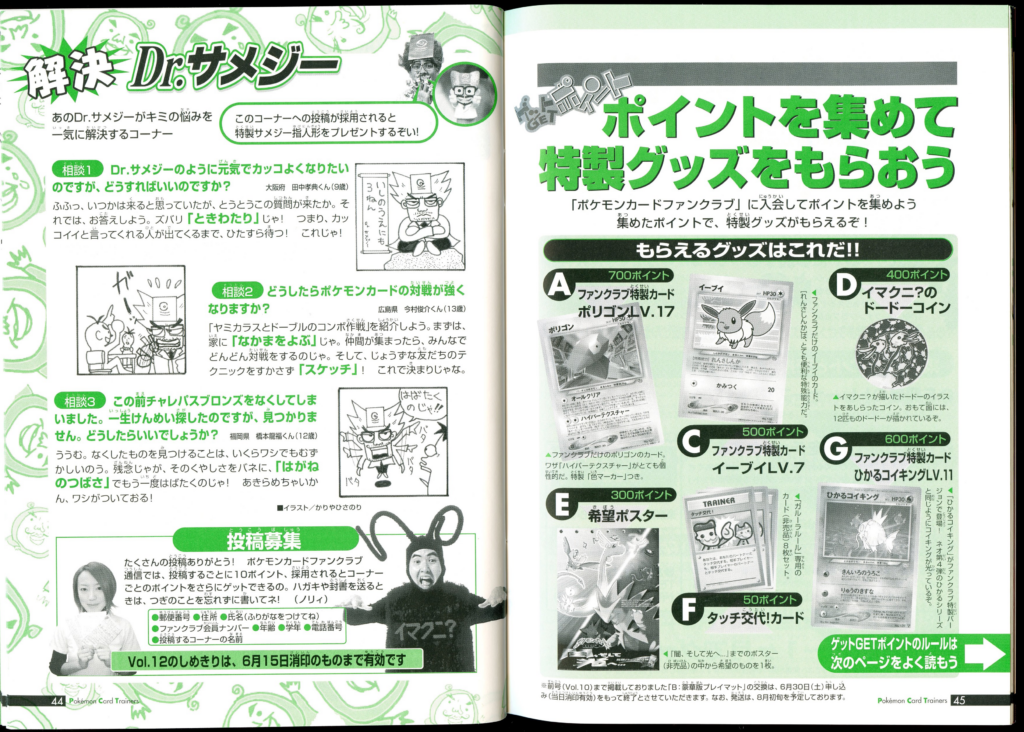
This Magikarp was added as “Prize G”, and replaced “Prize B” (the deluxe playmat) as the 600 GET Point reward.
The card was identical to the Shining Magikarp printed in the Japanese “Awakening Legends” expansion (Neo Revelation overseas), except instead of the card’s background being holofoil, the Magikarp itself was embossed with texted gold holofoil, similar to the Shining Pokemon printed in the “Darkness, and to Light…” expansion set.
This version of the card also lacks the triple star rarity symbol, and instead has no rarity symbol.
Vol. 14 Rewards
The January 2002 issue of Trainers magazine would update the GET Points reward list for a final time. This update removed several rewards and added new ones.

Posters and the Touch Change! card set was taken out, replaced by a variety of merchandise
- Official black TCG sleeves – 700 points
- Pokemon Card Neo Lanyard – 500 points
- Ho-Oh coin – 300 points (this was also available at Neo Summer Road 2001)
- Paper Playmat with Lugia / Ho-Oh design
Jumbo Postcards
Subscribers to the Pokemon Fan Club would routinely receive postcards in the mail that were stylized as Jumbo Trainer cards. These would be issued to celebrate events like New Years, or for the member achieving certain GET Point thresholds. These would also award the recipient with GET Points, automatically credited to their membership.
Each one of these postcards featured the Trainers magazine logo in the place of an expansion symbol.
This card was awarded to Fan Club members who accrued at least 100 GET points in the first half of 1999.
It also rewarded the member with 10 GET Points.
This card was awarded to Fan Club members who accrued at least 100 GET points after July 1999.
It also rewarded the member with 10 GET Points.
This card was the final Tropical Present awarded to Fan Club members who accrued at least 200 GET points after July 2001.
It also rewarded the member with 10 GET Points.
This card was sent to Fan Club members to celebrate the new year in January 2000.
It rewarded the member with 200 GET Points.
This card was sent to Fan Club members to celebrate the new year in July 2000.
It rewarded the member with 200 GET Points.
Legacy
The Pokemon Fan Club came to an end in December 2002, succeeded by the Pokemon Players Club in January 2003.
GET Points became EXP Points in the Players Club, but were accrued in very similar ways. However, the Trainers magazine ceased publication early in 2003, meaning that the main way to accrue points was to play in official events instead of interacting with the publication.
The Players Club also carried on the tradition of having exclusive promos in exchange for accruing these points. Some of these promos have gone on to become some of the most expensive promotional cards ever printed.
Sources
- Trainers Magazine Vol. 1 – 21, multiple pages
- https://web.archive.org/web/19990429041958/http://www.pockemon-card.or.jp/



